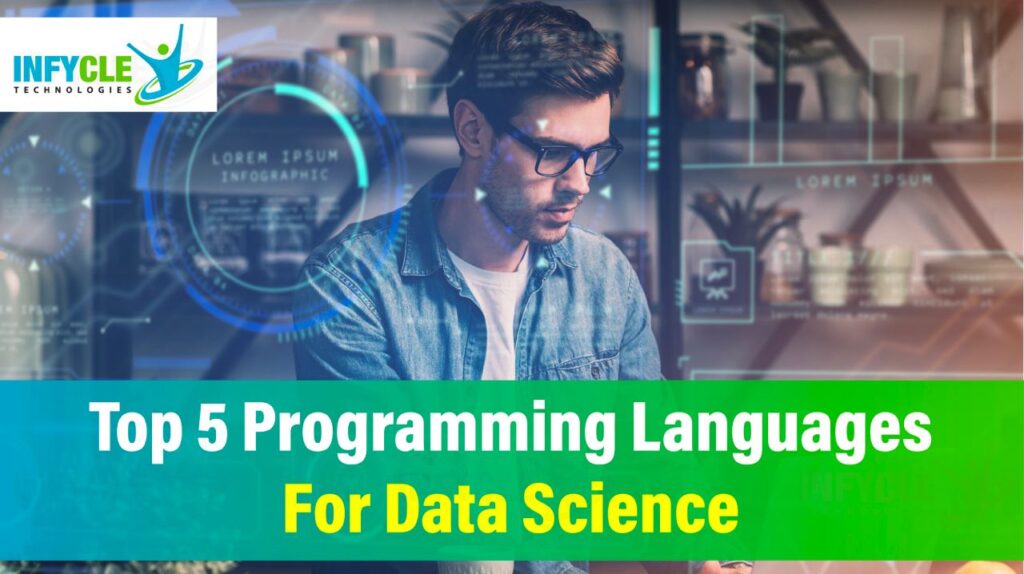Top 5 Programming Languages For Data Science
Data science is essential in today’s data-rich environment since it helps to extract useful information from massive volumes of data. The demand for qualified data scientists who are fluent in programming languages designed specifically for data analysis and machine learning is now even greater due to the exponential growth in data output. Explore top 5 programming languages for data science!
Although data scientists and software engineers frequently utilize the same technologies, their approaches to using them vary greatly. People who want to work as data scientists should be aware of the differences between software and data science programming.
Your decision on which programming languages to study can be crucial to your success, especially when it concerns data science. There are numerous options available; it can be difficult to decide which one to pursue. Therefore, we’ve compiled a list of the five most popular data science programming languages.
Firstly, let’s take a brief look at data science.
What Is Data Science?
The field of data science involves analyzing structured and unstructured data using scientific techniques, systems, and algorithms. To analyze and understand complex data sets, it integrates several disciplines, including programming, machine learning, statistical computation, and data analysis. By using data science, we can make informed decisions and predictions based on patterns, trends, and relationships found in data.
Types Of Data Science Programming Languages
Let’s now examine the top programming languages that are most appropriate for learning data science. These languages have been deliberately chosen to offer a solid foundation of machine learning, data visualisation, statistical modelling, and data analysis. The distinct benefits that each language provides enable data scientists to address a wide range of problems and realise the complete potential of insights derived from data. No matter what your experience level, whether you’re a beginner new to the field or an experienced data scientist interested in developing your skills, acquiring proficiency in these Top 5 Programming Languages for Data Science is essential for everyone looking to succeed in the quickly developing field of data science. Enrolling in the best software training institute in Chennai would help you acquire knowledge in data science.
Python
Today, Python is considered one of the most common data science languages because of its advanced multipurpose capabilities. Beginners will find it ideal because of its easy-to-learn syntax, which emphasizes readability and lowers program maintenance costs.
Because of its versatility, Python is used for a wide range of applications, including scientific computation, machine learning, artificial intelligence, and software and website development. Python, however, truly shines when used in data science. Python’s standard library and additional packages offer extensive resources for data handling, including libraries and modules.
Another factor in Python’s popularity is its ease of reading and simplicity. Because of its simple syntax, developers may produce code that is easy to read, comprehend, and maintain. If you’re just getting started with data science, Python is a beginner-friendly language because of its big and vibrant community, which offers a wealth of tools, tutorials, and documentation.
You can make use of online tutorials, classes, and books to begin programming using Python for data science. Enrolling in Python training in Chennai offers you comprehensive, personalized learning paths.
R
R is a must-discussion language when talking about Data Science. Mathematicians created R for mathematicians, so it’s safe to say that it’s among the greatest languages for data science! it has a vibrant community, and a large number of the most advanced libraries, and is highly favored (despite Python’s strong competition!). Many R libraries contain a vast number of functions, tools, and techniques for organizing and analyzing data. With some libraries handling both image and text data, and others handling data manipulation, data visualization, website crawling, artificial intelligence, and so on, each of the libraries of R focuses on a certain area.
Despite having a more challenging learning curve than Python, R is still an invaluable tool for data science programming because of its distinct features. You can make use of online tutorials and webinars to get started with R. To better understand R, you can also look into open source materials like the official R website, which offers examples, workshops, and documentation.
SQL (Structured Query Language)
The creators specifically designed Structured Query Language (SQL), a special-purpose language, to handle and modify relational databases. Although SQL isn’t a multipurpose programming language, it plays a big role in the data science sector. You can use SQL to obtain, insert, update, retrieve, and change data stored in a database. Recent surveys show that about 80% of the world’s data is stored in databases that use SQL. Thus, SQL is essential for dealing with large datasets since it offers the ability to derive important results and find answers to complicated problems from enormous volumes of recorded data.
Since data is the foundation of procedures for making decisions, almost every organization needs people with SQL expertise. Nearly all data science opportunities require some level of SQL competence because experts with this language can swiftly filter out and analyze huge volumes of data, whether it be for client details, business transactions, or data related to performance.
You can begin learning SQL for data science programming by looking through online tutorials and courses. For thorough descriptions and illustrations of SQL syntax, read the product documentation of well-known database systems such as MySQL, PostgreSQL, and Oracle.
Java
The “Write Once, Run Anywhere” characteristic of Java programming languages makes them popular. Leading companies use it for business development, data analysis, data mining, and artificial intelligence tasks. It can provide results far more quickly compared to other languages and has an extensive ability to create sophisticated applications from scratch.
People often believe that Java is a language suitable only for beginners, but this belief does not reflect reality. Java’s great strength enables it to support a wide range of complex activities in natural language processing, deep computing, and statistical analysis.
Java’s real garbage collection sets it apart from most other languages. Because Java employs a real garbage collection system, it operates significantly more efficiently than most languages that self-erase after execution.
To learn more about Java and its career opportunities, check out our blog “Is Java Enough To Get A Job?”
MATLAB
As a programming language for mathematical computations, MATLAB is very necessary for Data Science. Data science heavily relies on mathematics. MATLAB is so popular because it allows users to model mathematical functions, process images, and analyze data. Additionally, it contains an enormous amount of mathematical functions related to filtering, problems with differential equations, algorithmic integration, optimization, statistics, Fourier transformation, and linear calculus, that are helpful in data science. Along with all these, MATLAB also offers built-in graphics that users can use to create data visualizations with various plots.
Conclusion
Data science is rapidly expanding and in high demand, requiring several programming languages for various specializations and disciplines. There are specific advantages for all of these programming languages in the field of data science. The language you choose will depend on the specific tasks you need to accomplish, your level of comfort with it, and the particular demands of your organization or team.
Data scientists often prefer Python and R because of their large libraries and vibrant community support, making them ideal choices. Your data science career will be more flexible and broader if you learn several languages.
Always keep in mind that your knowledge of the data and the fundamental trends that it contains matter. This matters more than the language you implement. You can only use programming as a tool to find those trends and draw conclusions. Select the programming language that most closely matches your requirements, settle in, and begin learning about the field of data science.





